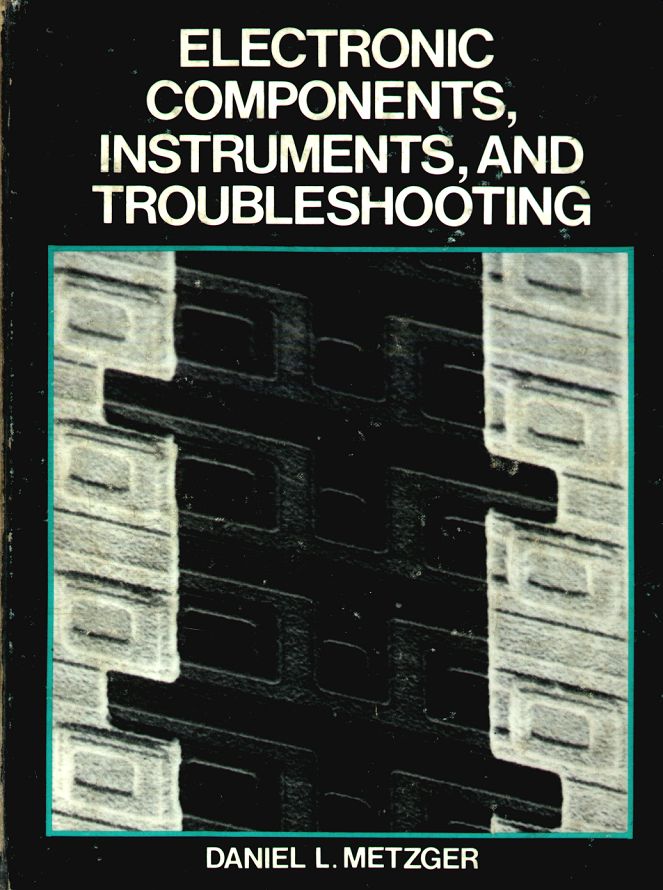Contents
PREFACE (this page; see below Contents section)
PART I--REAL VERSUS IDEAL COMPONENTS
1 Properties of Real Wire and Cable
2 Properties of Real Resistors
3 Properties of Real Capacitors
4 Properties of Real Inductors
5 Properties of Real Transformers
6 Batteries, Fuses, Switches, and Lamps
7 Diode Types and Characteristics
8 Transistor Types and Characteristics
9 Triggered Semiconductor Devices
10 Statistics of Component Variation
PART II---INSTRUMENTATION AND SIGNAL PROCESSING
14 Transducers and Control Systems
15 High-Performance Amplifiers
17 Transmission Lines and Attenuators
18 Frequency-Selective Filters
20 High-Performance Power Supplies
PART III --- TROUBLESHOOTING AND RELIABILITY
25 Tips for Technicians--A Potpourri
PREFACE

This guide is based on the book Electronic Components, Instruments, and Troubleshooting (1981).
Here is a guide which bridges the gap between electronics as it is taught in the classroom and electronics as it is practiced in the industry. The author, drawing upon his own experience in four different industries, shares with the reader a wealth of tips and insights which mark the difference between the inexperienced beginner and the practiced professional.
The approach is strictly practical--none of the nasty realities are omitted because they are not theoretically pretty, and none of the theoretical niceties are included unless there is a solid practical reason for them. Here you will find frank and numeric discussions of stray inductance and skin effect in hookup wire, leakage in various types of capacitors, turn-on surge in power transformers, and response times of various photodetectors. You will also find quick and easy methods for:
. statistical sampling of batches of components
. converting decibels to voltage ratios and back, instantly, in your head
. analyzing and designing attenuators and filters
. designing modern power supplies, including IC regulators, foldback short circuit protection, and switching regulators
. troubleshooting electronic systems without getting more involved than you have to.
In scope, the guide is designed for the person who has completed a study of basic electronics (including power supplies, amplifiers, oscillators, and transistor fundamentals), but who recognizes that there is a considerable gap between this elementary knowledge and current industry practice. The mathematical level of the discussions is held to a minimum. Basic algebra and right-angle trigonometry are adequate as prerequisites. The topical coverage is broken into three units:
. Unit I provides an in-depth look at the real properties of modern electronic components--from hookup wire to large-scale integrated circuits-gleaned from manufacturers, literature and from numerous lab tests revealing limitations which manufacturers often choose not to publish.
. Unit II starts with the basics of a course in electronic instrumentation and adds sections on high-performance amplifiers, op-amp applications, and modern power-supply circuits.
. Unit III outlines an approach to troubleshooting that is specific as to methodology yet applicable to any type of equipment. Notes on selection and use of test equipment and wiring practices are included.
Special attention has been given to make the Table of Contents at the front and the Index at the back of this guide as complete as possible. Take the time now to thumb through and become familiar with them. A tremendous amount of information has been compressed between these two covers, and if you learn to use the Index and Table of Contents well, you will find yourself reaching frequently for this volume as a reference in solving practical problems in the art of electronics.
It has been my good fortune to have the cooperation of numerous industries in preparing the material for this guide. In addition to the acknowledgements appearing with figures throughout the text, I would like to express appreciation to the following individuals who reviewed portions of the manuscript in their areas of specialty, and in many cases made important corrections and additions:
A.P. Gabriel, Alpha Wire Corporation, Section 1 on Wire and Cable; Jack R. Polakowski, Allen-Bradley Co., Section 2 on Resistors; F. Woody Brooking, Kemet Division of Union Carbide Corp., Section 3 on Capacitors; S. Vincent Burns, Caddell Burns Mfg. Co., Section 4 on Inductors; B. G. Merritt, Eveready Division of Union Carbide Corp., Sections 6.1 and 6.2 on Batteries; H. A. Fishel, S T Semicon, Inc., Section 7 on Diodes; Robert M. Mendelson, RCA Corporation, Section 8 on Transistors; Jack Takesuye, Motorola Semiconductor Group, Section 9 on Triggered Semiconductors; Kathleen Emery, Statistical Analyst, Blue Cross of Northwest Ohio, Section 10 on Statistics; Barry Siegel, National Semiconductor, Section 19 on Signal Processing.
Thanks are also due to three others who proofread the entire manuscript:
Professor Emeritus Robert C. Carter of Atlanta, Georgia, whose mastery of both the Language and the technology might have given me an inferiority complex had he been less of a gentleman; Professor Leon Heselton of Fulton-Montgomery Community College in Johnstown, New York, whose attention to detail uncovered several errors in mathematics and notation; and my good friend and colleague at Monroe County Community College, Tim Maloney, whose final reading of the page proofs eliminated errors that had escaped all others.
Readers having knowledge of errors or new developments in areas covered in the text are encouraged to communicate with the author through the Editor for Electronics Technology at Prentice-Hall, Englewood Cliffs, NJ 07632.
Finally, lest there be any misunderstanding, let me say that I am delighted at the recent entry of women in significant numbers to my chosen field. At the same time a respect for the grace of the Language prevents me from littering the text with he and/or she constructions. Until we develop a neutral personal pronoun, please understand he to refer to both sexes.
-- Temperance, Michigan; Daniel L. Metzger
Monroe County Community College
Monroe, Michigan, USA
Prentice-Hall , Inc., Englewood Cliffs, New Jersey, 07632, USA